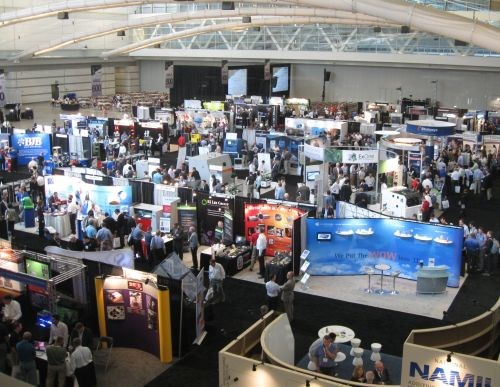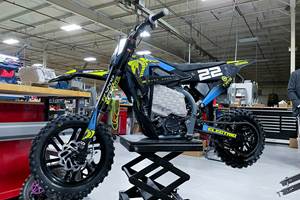Rapid Show Reveals Interest in Additive Manufacturing for Production
Interest in additive manufacturing was evident at last week’s Rapid show in Pittsburgh.

Interest in additive manufacturing was evident at last week’s Rapid show in Pittsburgh. Rapid is SME’s annual event focused on additive manufacturing technology and applications. At the show last week, the exhibit hall bustled and the conference sessions were frequently packed. Attendance nearly doubled that of last year, says SME. A veteran exhibitor told me he thought the opening day last week might have been the busiest day he’s ever experienced at a trade show.
However, it’s not just the quantity of attendees that distinguished this year’s show. The nature of those attendees was different as well. This year seemed to be the moment when Rapid transitioned from being focused on 3D printing as an aid to visualization and design, toward being focused on additive manufacturing more as a means of producing industrial parts.
Certainly that was the focus of a significant share of attendees, particularly those coming to the show for the first time. I thought I caught evidence of this when a keynote speaker asked for a show of hands from people who were attending the show for the first time. Perhaps 30 percent of the hands went up. But at a standing-room-only conference session focused on applying additive manufacturing to making end-use parts, the speaker asked the same question. This time, about 70 percent of the hands went up. The difference told me that, among the newest attendees to the show, the lion’s share of them were interested in additive manufacturing specifically for production applications.
A CNC shop owner I know gave me an example of this. He was at the show for the first time. When I ran into him, he pulled a machined part out of his pocket to show me why he had come. The complex part was difficult to machine, and he was here to explore whether additive manufacturing would enable him to produce it more efficiently.
Other points worth noting:
● While the show was underway last week, two important developments related to additive manufacturing were announced. 3D Systems announced plans to acquire most of Phenix Systems, marking the parent company’s move into metal part production. Meanwhile, GE announced two “Open Innovation” contests awarding cash prizes to entrepreneurs for redesigning an industrial part and demonstrating advanced 3D printing technique.
● NAMII’s presence at the show was interesting. The organization aims to be an encourager of additive manufacturing and a connection point for companies advancing the technology, and it illustrated this role with a booth that was essentially a giant wrap-around whiteboard inviting Rapid visitors to engage by sharing their thoughts. Speakers giving talks inside this booth were accompanied by NAMII personnel spontaneously taking notes on the booth’s surface as they spoke. The effect was energetic and, to put it plainly, fun. The photo below illustrates this—here are Tim Pasterik of ExOne and Greg Morris of GE speaking in the NAMII booth. (Consider also what this photo says about the maturing of this technology and the likelihood of its staying power. Here are employees of two publicly held American companies committed to the technology, speaking as guests of a government organization founded on that same commitment.)

Related Content
How Norsk Titanium Is Scaling Up AM Production — and Employment — in New York State
New opportunities for part production via the company’s forging-like additive process are coming from the aerospace industry as well as a different sector, the semiconductor industry.
Read MoreNew Electric Dirt Bike Is Designed for Molding, but Produced Through 3D Printing (Includes Video)
Cobra Moto’s new all-electric youth motocross bike could not wait for mold tooling. Parts have been designed so they can be molded eventually, but to get the bike to market, the production method now is additive manufacturing.
Read MoreCasting With Complexity: How Casting Plus 3D Printing Combine the Strengths of Both
Aristo Cast is advancing a mode of part production in which casting makes the part, but 3D printing enables the geometry.
Read MoreHow to Build 10,000+ Shot Molds in Hours
Rapid tooling isn’t so rapid when it takes days to 3D print a metal mold, and then you still must machine it to reach the necessary tolerances. With Nexa3D’s polymer process you can print a mold in hours that is prototype or production ready and can last for more than 10,000 shots.
Read MoreRead Next
To Improve Performance of Compression Molded Composites, Add 3D Printed Preforms
9T Labs' Additive Fusion Technology enables the manufacture of composite structures with as much or as little reinforcement as is necessary, using 3D printed continuous fiber preforms to add strength just where needed.
Read More3D Printing Brings Sustainability, Accessibility to Glass Manufacturing
Australian startup Maple Glass Printing has developed a process for extruding glass into artwork, lab implements and architectural elements. Along the way, the company has also found more efficient ways of recycling this material.
Read MoreVideo: Intelligent Layering Metal 3D Printing at 3DEO
Contract manufacturer 3DEO delivers metal parts using Intelligent Layering, a binder jetting-like 3D printing process the company developed and operates internally. Here’s how it works.
Read More
.jpg;width=70;height=70;mode=crop)











.png;maxWidth=300;quality=90)










